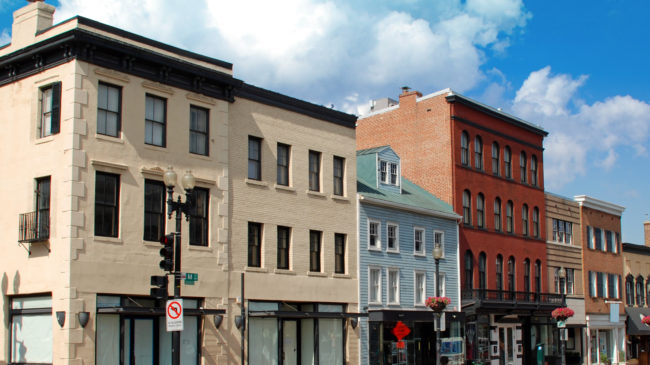The coronavirus pandemic promises to accelerate America’s retail apocalypse by driving up commercial vacancies in downtown areas across the country. These vacancies will likely cause a variety of issues, including urban blight unless cities take remedial action. To combat this decline, city governments should consider easing restrictions on the ability of businesses to use public space and encourage commercial-to-residential conversions. Implementing these policies and doing away with unnecessary regulations would allow unused or deserted commercial spaces to be used in innovative and profitable ways going forward.
Before the coronavirus pandemic, stay-at-home orders and economic lockdowns caused the economy to come to a grinding halt, brick-and-mortar retail businesses were already feeling financial pressure due to the rise of e-commerce. Aside from reduced demand, many establishments were also facing higher rental and labor costs. In 2019, San Francisco, for example, reported a 12 percent vacancy rate across its 24 neighborhood retail districts. Around the same time, New York City calculated an 11.6 percent vacancy rate—above the range of 5-to-10 percent that is considered to be “healthy.”
Restaurant and store closures have accelerated in recent months due to the coronavirus crisis. While shelter-in-place orders prevail, many restaurants and retailers have temporarily closed or are being restricted to take-out and curbside pickup services. Many state and local lockdowns are being relaxed, but businesses’ revenues are likely to continue to be limited due to some consumers not being willing to visit stores and restaurants at this time, along with the need to use space to accommodate social distancing for customers who do come in. Restaurants will need too separate diners and stores will limit the number of shoppers in their buildings.
Unfortunately, many business owners may not be able to reduce their costs to match lower revenues because rent and other expenses are largely fixed. Stores and restaurants that were marginally profitable before COVID-19 are likely to become unsustainable. Older proprietors may choose early retirement rather than undertake the challenge of transforming their businesses for the socially-distant world; even if they may be able to operate profitably.
The expected wave of closures will be a challenge for cities because they’ll face a decline in sales tax revenue and possibly reduced property tax revenue as well if landlords become delinquent or assessed property values decline. In addition to reduced tax revenue, cities may face additional law enforcement and sanitation costs from unused buildings, which can become magnets for vandalism, squatting and crime.
Clusters of commercial property vacancies could produce a cascade of problems that deter pedestrians, reduce traffic to remaining stores, and spur additional closures. To avoid such a downward spiral, cities should reduce unnecessary restrictions that may prevent businesses from adjusting to the realities of the coronavirus pandemic.
Cities may be able to help some restaurants by allowing them to place tables on adjacent sidewalks or streets so they can accommodate diners while keeping tables six feet apart. A similar approach may work for certain classes of retailers: allowing them to display some goods outside their physical stores may increase sales. These types of policies should be applied in a way that balances the interests of owners, customers and those who are simply passing through. For example, long-term closures of a given commercial street to vehicular traffic may be good for local commerce, but it can also exacerbate traffic on neighboring streets. Instead, evening and weekend street closures may provide most of the commercial benefits without hampering commuters and those running daytime errands.
Other small business preservation policies some cities may wish to consider include the relaxation of local minimum wage laws, restrictions on opening hours, alcoholic beverage licensing requirements and other potentially harmful regulations. By allowing small business owners to lower their operating costs, cities may enable them to stay open despite lower sales.
Whatever actions cities take, they are likely to have fewer stores and restaurants in the years ahead. As working from home becomes more popular, converting these retail spaces to offices probably won’t pencil out. Cities, at least those with stable or growing populations, can address lower demand for commercial space by facilitating retail-to-residential conversions.
In recent years, conversions of this type have been happening but at a low rate. New York City granted only 91 permits to convert commercial spaces to residential uses in 2017. One deterrent to such conversions has been the large gap between commercial and residential rents. But as commercial owners come to grips with the reality that their units are unlikely to find new commercial tenants, they may become more open to such conversions.
Converting a store to a single home is the lowest cost approach to residential conversion. A more expensive option is to demolish one or more commercial units and erect an apartment building instead. Such projects may allow cities to capture more property tax revenue from a given parcel or group of parcels. It remains to be seen whether developers will find such projects attractive in the weaker economic conditions that now prevail but cities can encourage the transformation of commercial properties to residential units though de-zoning and re-zoning, accelerated permit approvals and reduced permitting fees.
As cities adjust to a new normal of lower revenues, they may face pressure to raise sales and property taxes. But such measures may only further hinder the economic recovery. Over the long-run, local governments may achieve better revenue performance by rightsizing their commercial corridors and reducing public space use restrictions to enable remaining businesses to thrive.


